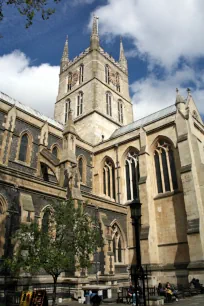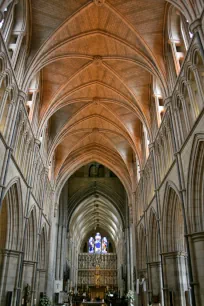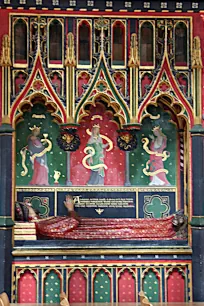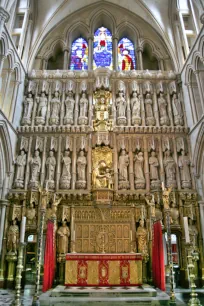Southwark Cathedral is one of London’s most interesting churches, with a history that goes back to the twelfth century. Inside visitors find plenty of monuments, memorials and beautiful stained-glass windows.



The cathedral is one of only a few historic buildings in Southwark that survived the nineteenth century. Many of the historic buildings in this neighborhood on the south bank of the River Thames were demolished to make way for the construction of railroads and the London Bridge. The cathedral only barely survived – the ramp to the London Bridge and the elevated railroads are just meters away.
The cathedral is commonly known as Southwark Cathedral, but its official name is Cathedral church of St. Saviour and St. Mary Overie. The suffix ‘overie’ stems from the church’s position ‘over the river’.
History
The history of the church starts in 1106 when it was built as part of the Augustinian priory of St. Mary Overie, possibly at the site of a smaller church that might have stood here since the early seventh century. In 1212, the Great Fire of Southwark completely destroyed the church, but reconstruction started only a few years later.
By the turn of the nineteenth century the church had fallen into decay and a series of renovations took place during the following decades. The tower and retrochoir were restored in 1822 and in 1838 the nave was completely rebuilt, only to be rebuilt once again in 1890-1896 in the style of the thirteenth-century chancel. In 1823 plans to demolish the Lady Chapel to make room for the ramp to the new London Bridge were only shelved after they were met with fierce opposition from locals.
In 2000 the church – which only received its cathedral status in 1905 – was renovated and at the same time expanded with a library, a refectory, a shop and visitor center.
The Cathedral



Despite the many reconstructions and renovations throughout much of its nine-hundred-year long history, the church’s appearance is homogenous in style and balanced in proportion.
The tower
The iconic crossing tower, built in the fourteenth century, is decorated with four pinnacles that were added in 1689. The church is Gothic in style, with a mixture of French and English elements. There are several interesting tombs and monuments inside, often painted in bright colors.
Interior
In the south aisle is a monument erected in 1912 as a tribute to William Shakespeare, who lived in Southwark from 1599 to 1611. Reliefs in the background show the Southwark Cathedral and the nearby Globe Theatre, where Shakespeare’s plays were performed.
In the north aisle is the tomb of John Gower, a fourteenth-century poet. His head rests on three books: one in Latin, one in French and one in English. There’s another interesting monument in the same aisle, a thirteenth-century oak effigy of a knight in full armor.
In the north transept, you find a humorous epitaph at the tomb of Lionel Lockyer, a seventeenth-century quack who claimed he used sunbeams as an ingredient for his pills. Opposite his tomb is the Harvard Memorial Chapel, named in honor of John Harvard, who was baptized here in 1607.
Behind the altar is a magnificent screen that divides the choir and retrochoir. The screen was built in 1520 by bishop Fox of Winchester. The two rows of statues were added in 1905 and depict Christ, saints, bishops and people related to the history of Southwark Cathedral. A central gilded statue depicts Mary, to whom the church is dedicated.
Also of interest are the cathedral’s many stained-glass windows. Some of the most notable include those near the exit at the north aisle, created by the Victorian manufacturer Charles Eamer Kempe. It depicts people involved in the construction of the cathedral. The window near the monument to William Shakespeare shows figures from his plays.
- Next: Marble Arch
- More Sights & Attractions in London

